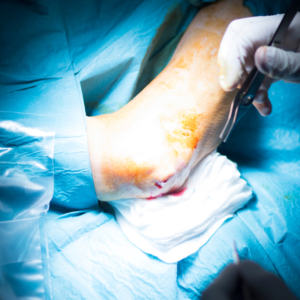
Are you an avid tennis player? Or maybe you’ve recently taken up gardening or woodworking? Whatever your passion may be, the last thing you want is to be sidelined by a nagging injury like Tennis Elbow. This common condition affects not just athletes, but anyone who repeatedly uses their forearm muscles. But don’t worry – there are steps you can take to prevent and treat this condition before it becomes a major issue. In this post, we’ll cover everything from the causes of Tennis Elbow to surgical options for treatment. So let’s get started and keep those forearms healthy!
What Is Tennis Elbow?
Tennis elbow, also known as lateral epicondylitis, is a condition that affects the outer part of the elbow. It is characterized by pain and tenderness in the area where the forearm muscles attach to the bony bump on the outside of your elbow. The condition usually occurs due to overuse or repetitive strain injury.
How To Know If You Have Tennis Elbow
Symptoms of Tennis Elbow can be quite uncomfortable and frustrating. The most common symptom is pain on the outside of your elbow that may radiate down to your forearm or wrist. This pain often worsens when you grip an object, flex your wrist, or rotate your arm.
In addition to pain, you may also experience weakness in your grip strength and difficulty with simple tasks such as opening a jar, turning a doorknob, or holding a cup of coffee. Your affected arm might feel stiff and sore after activities that involve repetitive motions like playing golf or typing for extended periods.
If you are experiencing any of these symptoms, it’s important to seek medical attention from a qualified healthcare professional who can diagnose the condition accurately. An early diagnosis will help prevent further damage to the tendons and muscles in your elbow.
Remember, ignoring these symptoms could lead to long-term complications such as chronic pain and limited mobility. Don’t hesitate to see a doctor if you suspect that you might have Tennis Elbow!

Causes Of Tennis Elbow
Tennis Elbow can be caused by any activity that involves repetitive use of the forearm muscles and tendons. This includes playing racquet sports such as tennis, pickleball, or squash, painting or carpentry work, using hand tools like screwdrivers and wrenches for extended periods, and typing on a keyboard for long hours without breaks. These activities put stress on the extensor muscles located in your forearm and can lead to inflammation around your elbow joint, resulting in pain.
There are several risk factors associated with Tennis Elbow including:
- Age (most common in people between 30-50 years old)
- Job-related activities that require frequent gripping or twisting of the wrist
- Improper technique during exercise or sports activities
- Ill-fitting equipment
The majority of cases of tennis elbow all boil down to one thing: overuse of the muscles and tendons in your arm. By taking steps towards prevention such as proper technique and conditioning exercises you can reduce your risk of experiencing this painful condition.
How Is Tennis Elbow Treated?
Diagnosing tennis elbow usually involves a physical examination by a healthcare professional, who will ask questions about symptoms and may perform certain tests. X-rays or other imaging tests may be recommended to rule out other potential causes of elbow pain.
There are several treatment options for tennis elbow, including non-surgical approaches such as rest, ice, compression, and elevation (RICE), over-the-counter pain medications like ibuprofen or acetaminophen, and physical therapy exercises to strengthen the affected area. In more severe cases, corticosteroid injections or surgery may be necessary.
For those experiencing pain from tennis elbow, applying heat or cold to the affected area can provide temporary relief from discomfort. Additionally, wearing an elbow brace during activities that exacerbate symptoms can help prevent further injury.
Overall management of tennis elbow requires patience and persistence with treatment methods until complete healing is achieved.
 Surgery For Tennis Elbow
Surgery For Tennis Elbow
When non-surgical treatments fail to provide relief, surgery may be recommended as a last resort. There are several surgical options available for those with lateral epicondylitis.
One popular option is open surgery where the surgeon makes an incision in the affected area and removes any damaged tissue. Another option is arthroscopic surgery, which is a minimally invasive procedure, involving the use of small instruments and a camera to remove or repair damaged tissue through tiny incisions.
Recovery time varies depending on the type of surgery performed but typically ranges from weeks to months. Post-operative physical therapy can help speed up recovery and improve overall outcomes.
It’s important to note that while surgery can effectively treat tennis elbow, it does come with risks such as infection or nerve damage. Therefore, it should only be considered after non-surgical options have been exhausted and under the guidance of a qualified physician.
As always, consult with your doctor about all treatment options available before making any decisions regarding your health.
How To Prevent Tennis Elbow
Preventing tennis elbow is essential for those who engage in sports or activities that require repetitive arm movements. Here are some ways to prevent the occurrence of this painful condition.
Ensure that you’re using the proper technique when performing any activity involving your arms. This means avoiding excessive force and twisting motions and using equipment that’s appropriate for your skill level.
Gradually building up strength and flexibility in your forearm muscles can help prevent injuries such as tennis elbow. You can do this by incorporating exercises like wrist curls, reverse wrist curls, and grip strengthening into your workout routine.
Taking frequent breaks during physical activity can reduce the amount of stress placed on your tendons. Ensure you take a break every hour or so if you’re engaging in an activity that requires constant arm movement.
Don’t forget to warm up before participating in any strenuous physical activity. A good warm-up will increase blood flow to the arm muscles which will prepare them for exertion and decrease the likelihood of injury occurring.
By following these simple steps consistently over time, you can significantly reduce your risk of developing tennis elbow while still being able to enjoy your favorite activities without pain or discomfort!
 Tennis Elbow FAQ
Tennis Elbow FAQ
Can Non-Tennis Players Get Tennis Elbow?
Yes. While tennis players are more prone to developing this condition due to the nature of their sport, anyone who engages in activities that require constant gripping and lifting can develop this condition.
What Lifestyle Modifications Will I Have To Make?
After being diagnosed with lateral epicondylitis, you will have to make certain lifestyle modifications in order to alleviate pain and promote healing. One of the most important changes that you can make is limiting or avoiding activities that aggravate the condition. This may include stopping participation in sports or temporarily ceasing work-related tasks that put stress on the affected arm. You may also benefit from modifying your exercise routine by incorporating stretches and strengthening exercises specifically designed for tennis elbow.
Will I Need A Brace Or Cast?
The decision to put a patient in a brace or cast for tennis elbow depends on the severity of their condition. A brace is often used to provide support and stability while allowing some movement, whereas a cast immobilizes the affected area completely. Braces are typically recommended for mild to moderate cases of tennis elbow, as they can help alleviate pain and reduce inflammation. In more severe cases of tennis elbow, where there is significant damage or risk of further injury, a cast may be necessary.
How Common Is It That This Condition Reoccurs?
Tennis elbow has a high rate of reoccurrence. This can depend on various factors such as age, severity of injury, underlying health conditions, and treatment adherence. This means that prevention methods such as proper warm-up exercises before engaging in physical activity are crucial in avoiding recurrent injuries.
Will The Pain From Tennis Elbow Affect Other Aspects Of Daily Life?
Tennis elbow can cause pain and limitations in daily activities such as gripping, lifting, and typing on the computer. Even simple tasks like turning doorknobs or holding a cup of coffee can be painful for those suffering from tennis elbow. If left untreated or ignored, the condition may worsen over time leading to chronic pain that could impair overall quality of life.
Can I Still Play Tennis While Recovering?
The answer largely depends on the severity of their condition and how well they are responding to treatment. For some patients, playing tennis may aggravate their symptoms and delay their recovery process. However, for others who have milder cases or who have successfully managed their symptoms through rest, physical therapy, or other treatments, it may be possible to continue playing tennis while undergoing rehabilitation. It is important for individuals with lateral epicondylitis to listen to their bodies and consult with a medical professional before returning to any activities that could potentially worsen their condition.
What Are Some Exercises To Prevent Tennis Elbow?
Strengthening the forearm muscles and improving flexibility can help prevent tennis elbow. Some recommended exercises include wrist curls, reverse wrist curls, and eccentric strengthening.
Can Tennis Elbow Heal On Its Own?
In some cases, mild cases of tennis elbow may heal on their own with proper rest and conservative treatment. However, it’s important to see a doctor if symptoms persist or worsen.
How Long Does It Take For Tennis Elbow To Heal?
The recovery time for tennis elbow varies depending on the severity of the injury and the chosen treatment plan. Mild cases can typically improve within weeks with rest and physical therapy, while more severe cases may take several months or longer.
Do I Need Surgery For My Tennis Elbow?
Surgery is usually considered a last resort option for treating persistent and severe cases of tennis elbow that have not improved with other treatments such as steroid injections, physical therapy, or medication.
If Surgery Is Necessary, What Is The Recovery Period?
Recovery from tennis elbow surgery varies, but most individuals can return to regular activity in four to six months.
Can Playing Sports Cause Both Arms To Develop Tennis Elbow At Once?
It’s possible but unlikely that both arms will develop Tennis Elbow at once from playing sports since this condition is caused by overuse rather than an acute injury.
Conclusion
Tennis elbow can be a painful and frustrating condition that affects athletes and non-athletes alike. The good news is that it can often be prevented or treated with a combination of rest, physical therapy, and other interventions. By understanding the causes and symptoms of tennis elbow, as well as the available treatment options, you can take steps to protect yourself against this common injury.
Remember to always listen to your body and seek medical attention if you experience persistent pain or discomfort in your elbow or arm. With proper care and attention, most cases of tennis elbow can be resolved within a few weeks or months, allowing you to get back to doing what you love without pain or limitations.

Hayley is a BOC Certified Athletic Trainer and State of Florida Licensed Athletic Trainer. She graduated with a bachelor’s degree in Athletic Training from Palm Beach Atlantic University in 2017 and is working on a master’s degree in Health Administration through St. Augustine University. In addition to working with our physicians she often works in our physical therapy department where she uses her certification in Graston, a soft tissue mobilization technique to help with soft tissue recovery. Full Bio







